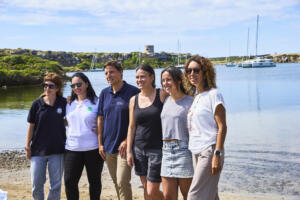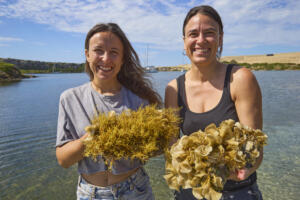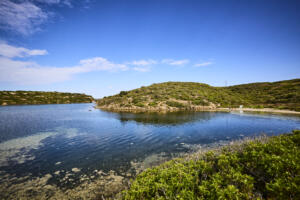Environmental entities join forces to improve the conservation status of shallow bays
The initiative, led by the OBSAM-IME, is underway in Maó, Fornells and Addaia, with the collaboration of the Marilles Foundation and Menorca Preservation.
Two of its objectives are to disseminate the importance of these habitats and to get institutions to act to conserve them

To contribute to the improvement of the conservation status of Menorca’s shallow bays. This is the main objective of the project ‘Conservation and restoration of shallow bays’ presented today by the Socio-environmental Observatory of Menorca (OBSAM-IME), the Marilles Foundation, Menorca Preservation and CEAB-CSIC during an event held in Cala Teulera (Maó). In addition to defining the current state of these bays and promoting conservation and restoration plans, two of its main objectives are to raise public awareness of the ecological importance of these habitats and to get the authorities involved in their conservation.
The bays studied so far have been Addaia, Fornells and Maó, but work with other bays is not ruled out in the future.

Implemented actions
This is the second phase of a larger project that was launched in 2022. During this time, OBSAM has been responsible for defining the conservation status of these bays and designing a programme for their recovery. It has also carried out active restoration tests on Gongolaria barbata, a species of algae of the genus Cystoseira s.l., in Cala Rata and Addaia and, in parallel, the population restored in previous years in Cala Teulera has been reinforced. The project has the scientific advice of Emma Cebrian and Enric Ballesteros from CEAB-CSIC, especially for the scientific-technical actions to be developed.
Specifically, Conservation and Restoration Plans have been drawn up for Addaia Bay and Fornells Bay. As for the bay of Maó, the initial diagnosis has been carried out and management measures are being drafted. The data on the population of the invasive pearl oyster (Pinctada radiata) in the three bays has also been updated. Part of the project and experience has also been used to feed the ecological carrying capacity study of Fornells Bay commissioned to IME by the Government of the Balearic Islands in 2023. In addition, temperature sensors have been installed in the restoration areas of the three bays.
Next steps: validate the plans and disseminate them through the ‘Dive into the bays’ campaign
The next step will be to validate the Conservation and Restoration Plans with staff from the administration and the public. For this reason, the plan is to organise workshops and colloquiums to publicise the plans and to gather the opinion of the people linked to these spaces on new measures and whether or not to validate the proposals.
In the same direction, Menorca Preservation and the Marilles Foundation, with the technical support of IME-OBSAM, have created the communication campaign ‘Immerse yourself in the bays’, with the aim of bringing the richness of these marine environments to the population. The campaign will be launched in the coming weeks through their social networks and will focus on disseminating the most curious and interesting aspects of these incredible marine habitats. What is a soma bay, why it is so important to preserve these environments or which are the species that inhabit them are some of the questions that will be answered through this campaign, which will last until the end of October.

A degraded area
Menorca’s shallow bays are home to a large number of unique habitats and species. However, many pressures such as poor water quality, the impact of shipping or coastal development pose a serious threat to them. This is why they have been considerably degraded over the last decades. The surface area of marine plants such as Posidonia or Cymodocea; algae of great ecological value such as Cystoseira, and emblematic species such as seahorses have diminished significantly in their waters.
Each of the bays presents different levels of degradation but they also hide special natural singularities.
Addaia
It is a bay made up of two long, narrow basins with a total surface area of 89 hectares, where we find small-big treasures such as the spectacular posidonia barrier reef of s’Estany, a Mediterranean example. Or, in the innermost part of the eastern basin, where the land-sea transition takes place, the Addaia salt marshes form a unique space for aquatic fauna and flora. These treasures, among others, are what made this area part of the S’Albufera des Grau Natural Park. Even so, the Plan’s diagnosis indicates that the bay is in an unfavourable state of conservation.
Fornells
This is the largest bay in Menorca with a basin of 409 ha. Here we can find the only natural population in Spain of Gongolaria barbata, a species of seaweed that only needs a snail shell or a small hard substrate to hold on to and develop. Of the three bays, Fornells is the one with the greatest variety of sporting and leisure activities, some of which are fully compatible with the conservation of the bay and others which exert more intense pressures, contributing to the deterioration of the marine habitats.
Maó
The bay of the Port of Maó has a basin of 324 ha. The historical side of it stands out, as it evokes a past marked by the importance of this port in the development of Menorca. This great human activity in the past and, to a large extent, in the present day, means that defining conservation and restoration measures is a real challenge. Maintaining the level of human activity and improving the state of conservation of the natural spaces that still remain will be a job for everyone.